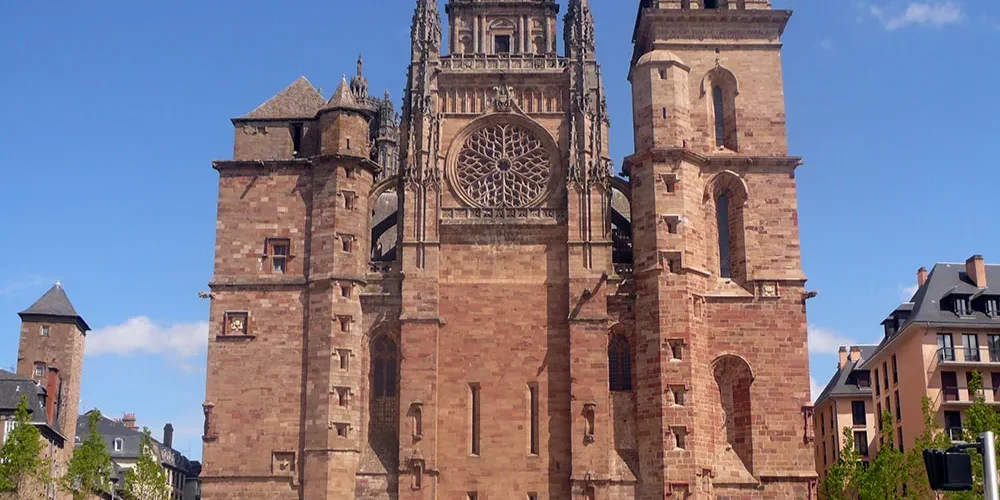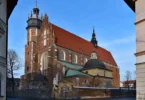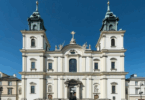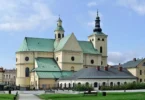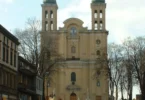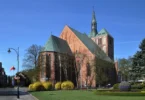Introduction

Rodez Cathedral (French: Cathédrale Notre-Dame de Rodez) is a Roman Catholic church located in town of Rodez, in the department of Aveyron in the Occitanie region of Southern France. The cathedral is a national monument and is the seat of the Bishopric of Rodez. The west front, of a military appearance and without a portal, formerly was part of the city wall of Rodez. Notable elements include a Flamboyant Gothic and Renaissance tower (17th century), and a Renaissance rood screen and choir stalls (17th century).
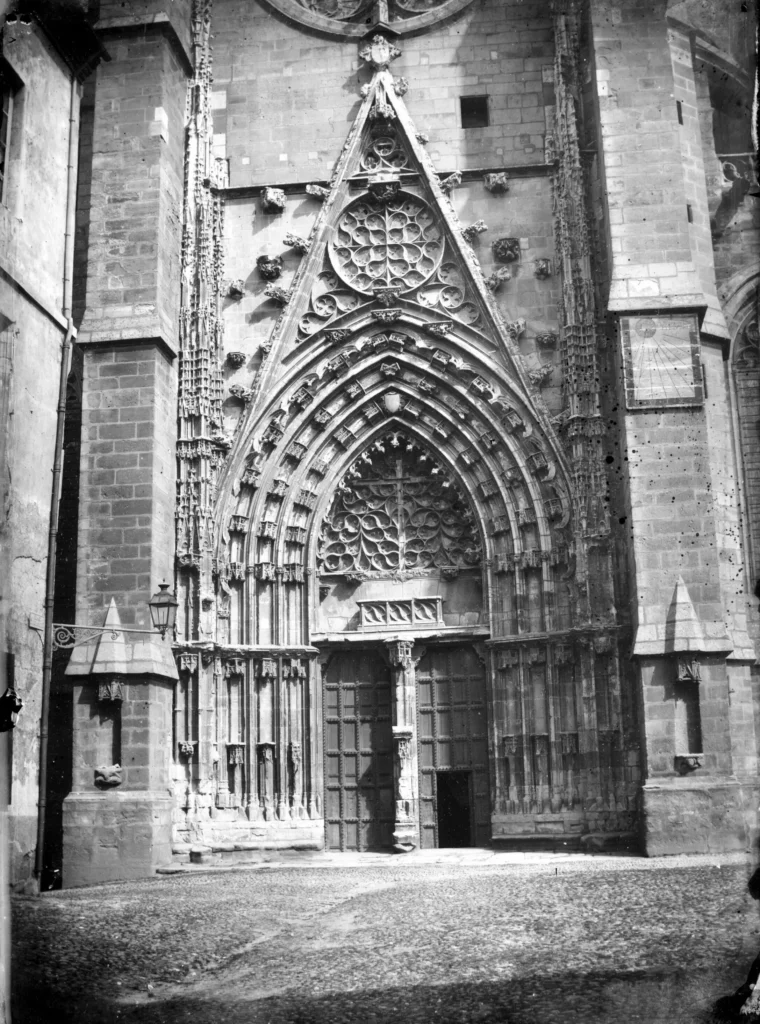
Rodez was Christianized in the 4th–5th century AD, and the first mention of a cathedral dates from the Merovingian period, in around 516, though little is known of its features. On 16 February 1276, the bell tower and roof of the choir of this early church collapsed. The construction of a new cathedral was begun, likely led by the Bishop Raymont de Calmont d’Olt, and master builder Jean Deschamps. The cathedral’s design was influenced by Clermont-Ferrand Cathedral and Limoges Cathedral as well as by the cathedrals Ile-de-France, an influence visible in features such as the blind arcades of the triforium and the strong sense of verticality. The first four-part rib vaults of the choir were installed, giving it a height of thirty meters, divided into three levels. The first chapel on the north side was finished in 1338. In the 14th and 15th centuries, the work was slowed by the Black Death and the Hundred Years War. Between 1366 and 1386 a new tower was constructed, at the northeast corner of the cathedral, crowned with a spire of wood covered with lead. However, the timbers of the tower burned and destroyed the upper levels. It remained unfinished for more than a century.
In the 16th century, thanks to the efforts of Bishops Francois D’Estaing, who raised the funds, and Georges d’Armagnac, work resumed. The vaults of the nave were finally finished, and a new tower was constructed upon the two levels of the earlier tower. The new tower, the work of the master mason Antoine Salvanh, was built between 1501 and 1529. The upper portions of the completed tower incorporated both Flamboyant Gothic features and elements of the new French Renaissance architecture. Following the French Revolution, the cathedral was closed for worship and was used as a storage depot for gunpowder, before it was returned to the Church in the early 19th century. In 1792–98, Pierre Méchain and Jean-Baptiste Delambre used Rodez Cathedral as the central surveying point for their calculation of the circumference of the earth. This was used in the definition of the metre (see History of the metre).
Genesis and Initial Construction
The origins of Rodez Cathedral date back to the early medieval period, although the current building was not built until the 13th century. Designed to replace an older church dedicated to Saint-Amans, its construction extended over the 13th and 14th centuries. During this period, the characteristic Gothic elements of the cathedral gradually took shape, starting with the choir and the first bays of the nave.
The 16th century marked a significant turning point in the history of the cathedral, under the leadership of Bishops François d’Estaing and Georges d’Armagnac. In 1503, Bernard Anthony, a renowned master builder, supervised the completion of the nave walls. Following a fire in the bell tower in 1510, Antoine Salvanh, a renowned architect, was commissioned to rebuild it between 1513 and 1526. Under his direction, the bell tower reached an impressive height of 87 metres, becoming one of the tallest flat bell towers in France. This reconstruction marked a transition to the flamboyant Gothic style, influenced by architectural trends from northern France, particularly those of Rouen Cathedral.
In 1526, the completion of the bell tower was celebrated by the consecration of the high altar of the choir, decorated at the time with brass columns that have now disappeared. The evolution of the cathedral continued with the introduction of Renaissance elements under the aegis of Bishop François d’Estaing, who ordered major modifications, including the Roman-style western façade, created by Guillaume Philandrier and Jean Salvanh around 1554.
Vicissitudes of the Revolutionary Period
The French Revolution had a considerable impact on the cathedral. In 1793, the building was subjected to acts of vandalism: the brass furniture of the choir was removed and sculptures were damaged. The bell tower was even threatened with demolition, a decision which was ultimately suspended. During this tumultuous period, the cathedral was reassigned as a temple of Reason and served as a training ground for volunteer battalions. It was not until 1795 that the building regained its function as a place of Catholic worship, although its treasure had been transferred to the Paris Mint.
Restoration and Redevelopment in the 19th Century
The 19th century was marked by major restoration and redevelopment work. In 1821, Étienne-Joseph Boissonnade was appointed diocesan architect and undertook restoration work, particularly on the roof frame and the bell tower, while restoring damaged sculpted elements. Restoration efforts continued throughout the century, with major interventions between 1858 and 1883 aimed at renovating the exterior and interior elements of the building. The Gothic rood screen was dismantled in 1872 and repositioned against the back of the south transept.
Architecture of the Cathédrale Notre-Dame de l'Assomption de Rodez, Rodez, France
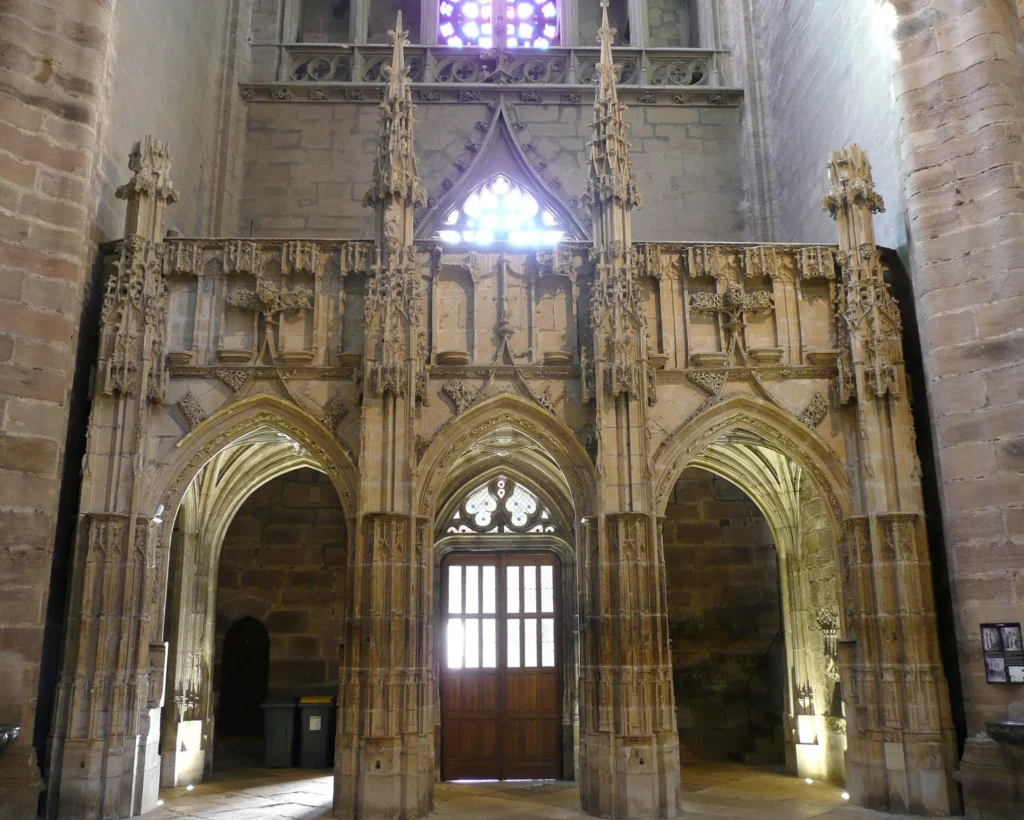
Architect: Guillaume Philandrier , Antoine Salvanh
Architectural Style: Gothic architecture , Renaissance architecture
Without concern for architectural unity, Georges d’Armagnac had the summit of the fortified façade of the Gothic cathedral crowned with a reduced model of an Italian church façade with door, colonnade and a classical frontispiece (pediment and spiral consoles) designed in 1562 by Guillaume Philandrier 17 . The choir, transept and nave are covered with a roof of local slate on a very high and steeply sloping frame. The side aisles and side chapels are covered with sandstone paved terraces. Because of their gentle slope, these terraces have been given the local name of planets.
Exterior
The construction of the church began in about 1277, and commenced with the chevet, at the east end, flanked by an imposing square tower on the north side, which was built up only two levels. Construction of the unfinished work resumed in the 16th century when Francois d’Estaing completed the north tower with a Flamboyant bell tower 87 meters high. The west front, with its own flamboyant decoration, was completed by Georges d’Armagnac between 1500 and 1562.
West Front
The lower portion of the west front at Rodez, the traditional entrance to Gothic cathedrals, is flat and plain, with narrow slit windows for defense and no large portal. It originally extended outside the city wall, and large doors or windows were avoided to prevent access by the attackers to the city. The lower are made of reddish sandstone, in the Gothic style of northern France. The upper levels of the west front were constructed between 1500 and 1562 by Bishop Georges d’Armagnac. The upper central vessel of the nave has a large rose window, while the two unfinished towers on either side are decorated with engaged columns. Above the rose window is a fronton in the new Renaissance style, the work of Jean Salvanh.
North Tower
The highly flamboyant north bell tower, 87 meters high, is placed on the north side of the tower. It was commissioned by Bishop Francois D’Estaing and completed in `1526 by master builder Antoine Salvanh. The tower is topped by a lantern which in turn is crowned by a statue of the Virgin Mary surrounded by four angels.
The Transept and Portals
Since the west front of the cathedral extended just outside the city walls, it did not have the traditional large portal on the west front. Instead, the entrances to the cathedral were on the north and south sides. In the sixteen century, A transept was constructed at the meeting point between the nave and choir, which reached out to the east and west and had very elaborate portals, topped by filled with sculpture, and further decorated with gables and pinnacles. Flamboyant rose windows were placed over the portals on the north and south transept. Much of the sculpture was smashed during the French Revolution, but other elements survived and were restored.
Interior
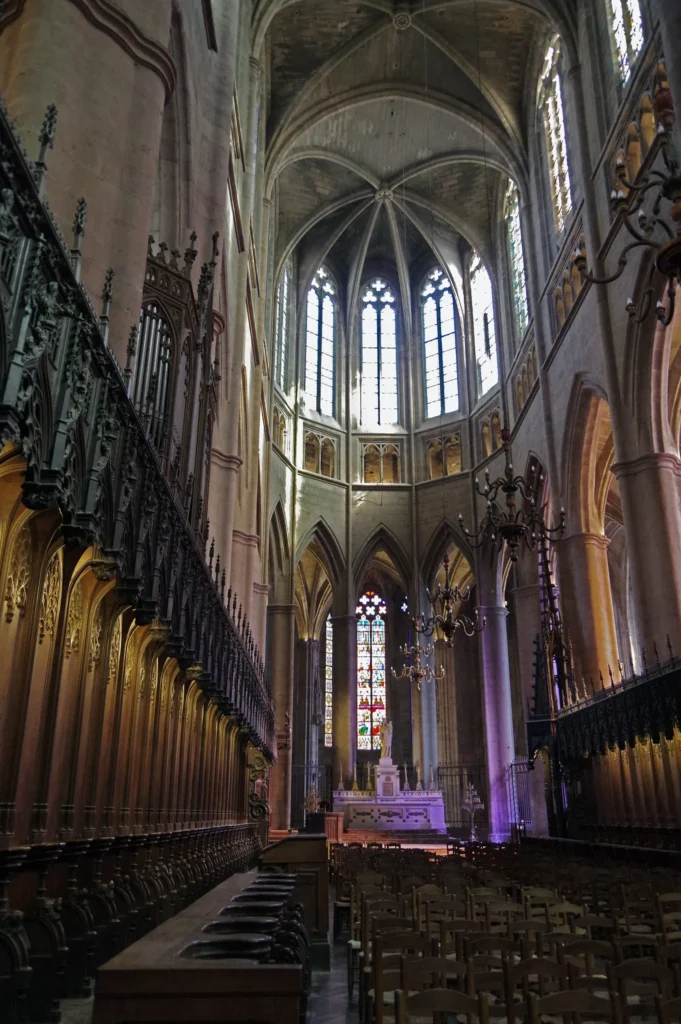
Nave and Choir
The nave and choir of the church are 101.57 meters long, 36.89 meters wide at the transept, and 30 meters high in the nave. The nave and choir are constructed with three levels, following the design of Ile-de-France cathedrals; massive pillars on the ground floor; a narrow triforium or passage above; and upper walls filled with windows. Slender columns run up the walls from the arcade pillars to support the four-part rib vaults.
Chapels
The cathedral has a group of radiating chapels within the apse, at the east end, accessed by a semicircular passage or deambulatory. It also has a group of chapels placed alongside the nave. The Chapel of Reconciliation has Renaissance decoration preserved from other parts of the buildings.
Decor of the Radiant Chapels

Carved furniture
Several funerary monuments are found in the chapels, dating from the 13th and 14th centuries. Tombs with epitaphs of Canon Brenguier d’Arpajon (died before 1325), Jean de La Baccalerie (died before 1330), Guiral de Montal (died in 1318), or Hector de Tourène (died in 1338), tomb-chests of bishops Gilbert de Cantobe, Raymond d’Aigrefeuilhe, canons Jean de Via and Galhard de Cardalhac (died in 1359).Two marble sarcophagi from the cemetery of the Saint-Amans church were placed in the first bays of the ambulatory.
Wall Paintings
14th century wall paintings have recently been discovered in the axial chapel or Canterbe chapel, for Bishop Gilbert of Canterbe (1339-1349), the chapel of All Saints and the chapel of Saint Agnes. The paintings on the vaults of the Canterbe chapel were made at the request of Gilbert of Canterbe. Those in the chapel of All Saints are contemporary with a foundation made in 1341 by the canon cantor Izarn de Cuzel. In 1978, a cycle of tempera paintings on the Life of Saint Eligius was discovered on the choir enclosure wall, on the ambulatory side and facing the chapel of All Saints. The limits of the dating can be fixed by the presence of a lion, the heraldic symbol of the house of Armagnac, Counts of Rodez until 1473, and the fact that the bay of the choir where these paintings are located was made from 1449.
Art and Decoration
Rodez Cathedral is one of the few Gothic churches that retains a rood screen or rood screen, placed between the choir and the nave. Most French rood screens were removed during the Renaissance, in response to a Vatican change in church doctrine intended to make the interior of churches more open and accessible to lay parishioners. The red screen was installed in 1478, under Bishop Bertrandt de Chalencon. In the 19th century, the choir screen lost most of its elaborate sculpture but otherwise was moved intact to its present location in the north transept. The choir stalls were also installed in 1478, and displayed a rich assortment of carved decorations, particularly on the misercordiae, the folding seats against which the clergy could find support when they were required to stand for long periods of time. They are decorated with carved Biblical figures and scenes.
Stained Glass
The cathedral has a mixture of early windows, 19th-century windows, and a series of modern windows depicting, among others, the subjects, the creation of the Elements. In some windows, early glass has been combined with more modern settings.
The Great Organ
The great organ is one of the famous features of the cathedral. The buffet was constructed in 1628 by Raymond Guimond de Périgueux to house an organ built by Vernohlles de Poitiers. The instrument was rebuilt in 1676 by Jean de Joyeux. It was reconstructed again in 1902 by Charles Anneessens, then rebuilt once again in 1986 by Jean-Georges & Yves Koenig to return it to its earlier form under Jean de Joyeux Joyeuse in 1986. Both the buffet and the instrument are protected in the list of French historic monuments.
The Bells
Rodez Cathedral is home to a total of twelve bells, with a fascinating history. Only one bell predates the French Revolution: the traditional clock bell, which was cast in 1523 and is no longer in use today. This bell is situated at the top of the bell tower, just below the pedestal of the Notre-Dame statue. Additionally, a smaller bell, known as “the Mandarelle,” is positioned above the roof directly over the transept. In 1847, the congregation of Notre-Dame commissioned a second small bell, which is located in the southwest tower. The remaining nine bells are housed within the bell tower itself, set in a wooden belfry. These bells were cast by Morel in 1851 and installed in 1853, creating a harmonious C major scale.
Current Status and Heritage Value
Today, Rodez Cathedral remains an emblematic monument, testing to the architectural evolution of the region. Its flamboyant Gothic facade, its imposing bell tower and its rich interior decorations continue to fascinate visitors. Recent restoration work has helped to preserve and enhance this exceptional architectural heritage. The cathedral retains its status as an active place of worship while establishing itself as a major tourist attraction, drawing many visitors keen to explore its fascinating history and admire its architectural grandeur.
Feast Day
Feast day: 15 August
The Annual Feast Day of Cathédrale Notre-Dame de l’Assomption de Rodez, Rodez, France, is celebrated on August 15 each year.
Church Mass Timing
Parish Masses are Celebrated at the Cathedral:
Tuesday : 8:30 a.m.
Wednesday : 8:30 a.m.
Thursday : 8:30 a.m.
Friday : 8:30 a.m.
Saturday : 8:30 a.m.
Sunday : 10:30 a.m. (until November).
Church Opening Time:
Monday : 8:30 am – 12:00 pm – 1:30 pm – 6:30 pm
Tuesday : 8:30 am – 12:00 pm – 1:30 pm – 6:30 pm
Wednesday : 8:30 am – 12:00 pm – 1:30 pm – 6:30 pm
Thursday : 8:30 am – 12:00 pm – 1:30 pm – 6:30 pm
Friday : 8:30 am – 12:00 pm – 1:30 pm – 6:30 pm
Saturday : 8:30 am – 12:00 pm – 1:30 pm – 6:30 pm
Sunday : 8:30 am – 12:00 pm
Contact Info
Address :
Rue Frayssinous, 12000 Rodez, France
Phone : + +33565871250
Accommodations
Connectivities
Airway
The Nearest Airport to The Church of Cathédrale Notre-Dame de l’Assomption de Rodez, Rodez, France, is, Rodez-Marcillac Airport, Route Decazeville, 12330 Salles-la-Source, France, which is just 14 min (10.7 km) via D840 away from the basilica.
Railway
The Nearest Railway to The Church of Cathédrale Notre-Dame de l’Assomption de Rodez, Rodez, France, is, Rodez Av. du Maréchal Joffre, 12000 Rodez, France, which is just 6 min (2.2 km) via Av. de Bordeaux/D994 away from the basilica.

